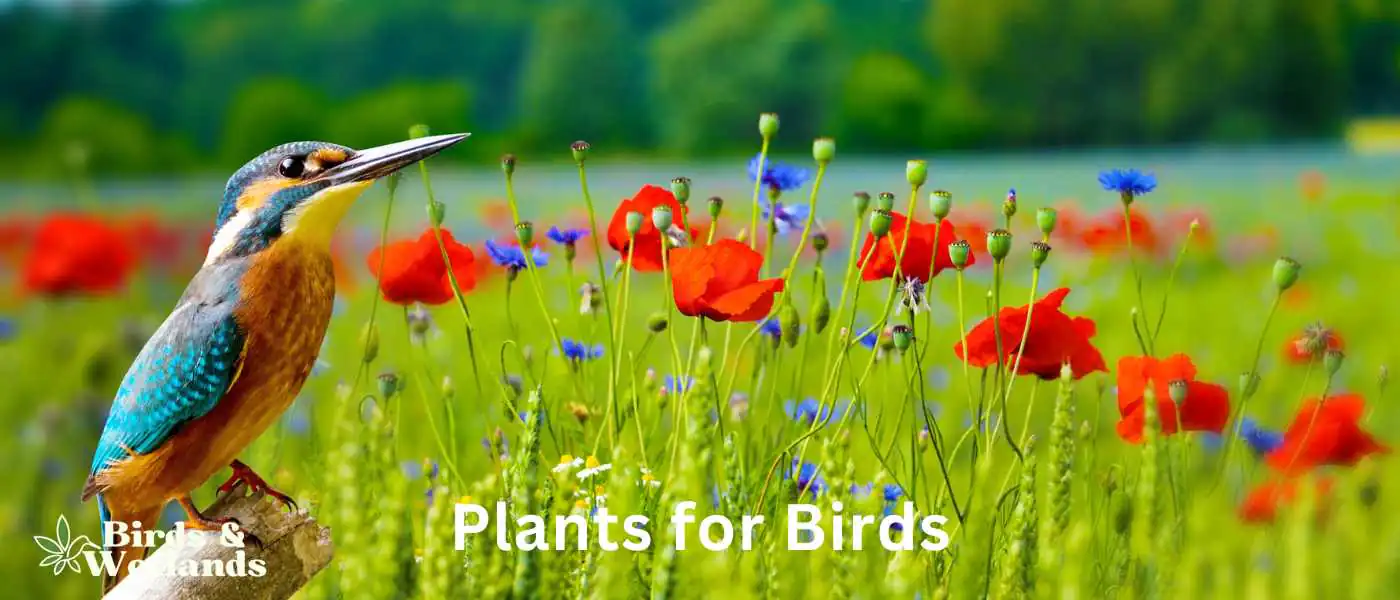Birds and plants go hand in hand. The right selection of plants in the backyard or garden can enhance the beauty and song of birds. Birders and native plant enthusiasts can attract a variety of birds by simply adding the right plants to your landscape. By providing food, shelter, and nest sites, you can create a bird-friendly environment that will bring joy and beauty to your life.
Birds are attracted to many plants that provide sustenance, such as sunflowers, coneflowers, coral bells, black-eyed Susan, and berry bushes.
If you’re looking to attract birds to your yard or garden, read on to learn more about what plants they love the most. By the end of this post, you’ll have a comprehensive list of the best bird plants, along with tips on creating a bird-friendly environment.
Get ready to welcome flocks of feathered friends to your backyard and enjoy their beautiful songs and graceful movements.
Key Takeaways on Best Plants for Birds
What are the best plants to attract birds?
Here’s a short list of bird-friendly plants you can grow in your garden or backyard:
Sunflowers
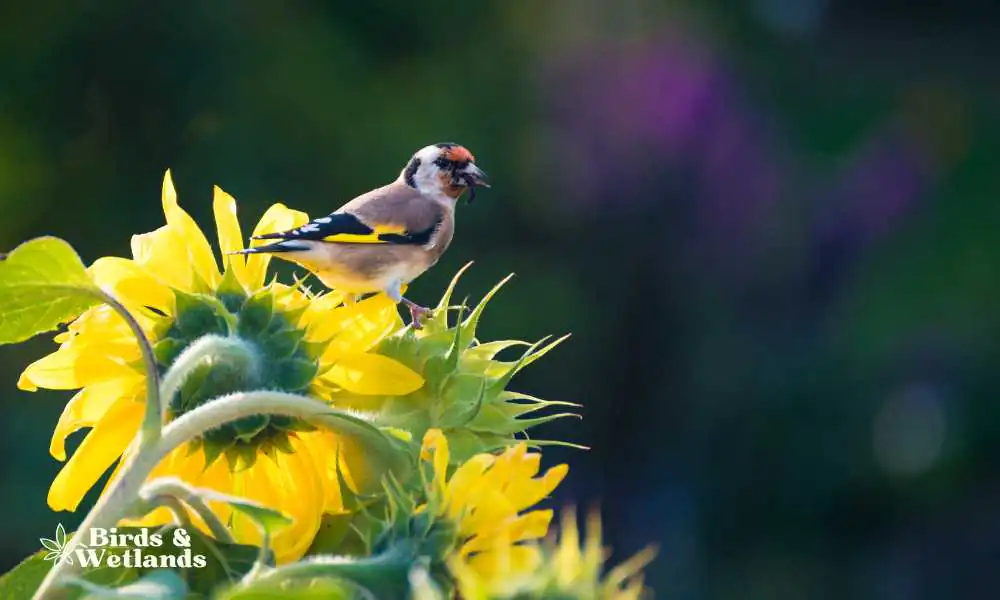
Sunflowers (Helianthus spp) are popular perennial flowers grown for their edible seeds. They are known for their bright yellow petals and large central disk, composed of hundreds of small flowers that produce a large amount of nectar. This nectar attracts a variety of bird species, making sunflowers a valuable food source for many birds during the warmer months.
Some of the most common bird species attracted to sunflowers include American goldfinches, house finches, black-capped chickadees, blue jays and other birds. These birds eat sunflower seeds and feed on nectar-rich flowers. They are also known to use the fibers from sunflower stems to construct their nests.
Sunflowers also offer shelter and protection. The large, bushy plants can provide cover for birds, especially during bad weather, and their seeds offer a safe place to hide from predators.
Elderberry
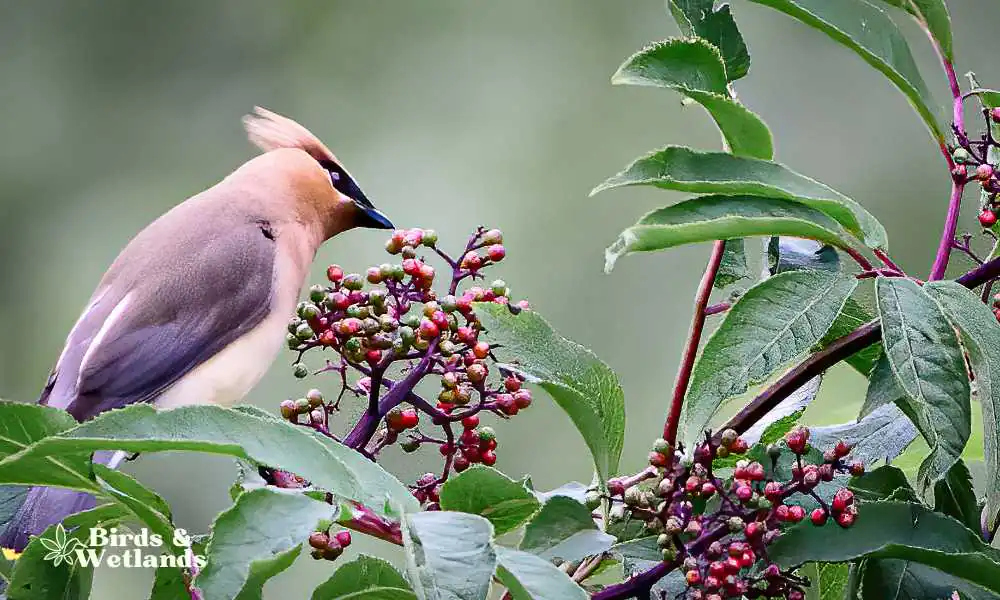
One of the most popular brushes that attract seed-eating birds is elderberry. Elderberry brushes provide a safe and abundant food source in the form of berries, nourishing an important source of sustenance for many backyard birds. These berry-producing brushes attract insects, which serve as an additional food source for the birds.
Elderberry brushes have clusters of branches and dense foliage that create a safe haven for birds to roost and build nests, keeping them sheltered from harsh weather conditions or potential predators.
Coneflowers
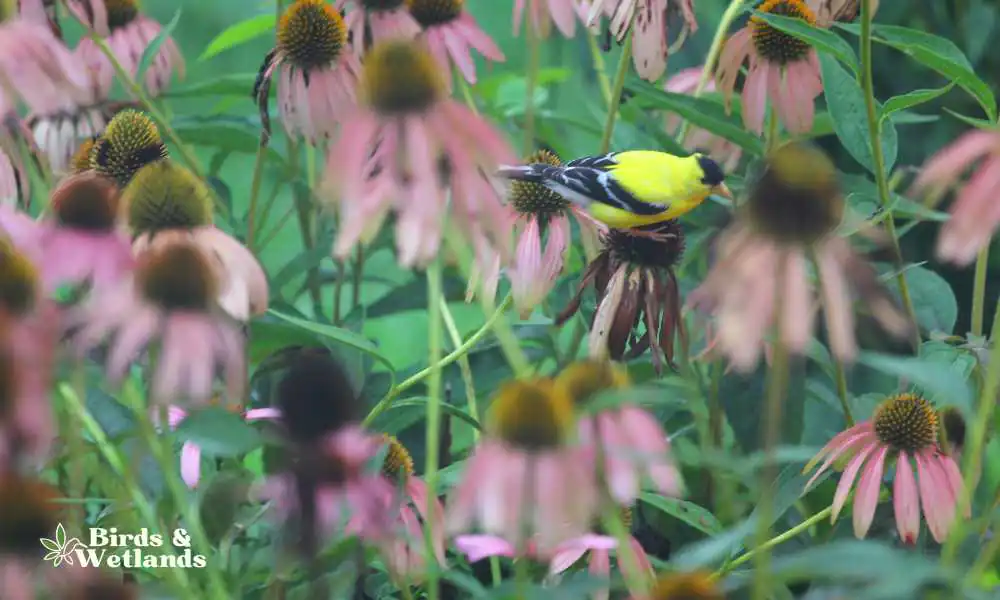
Birds are attracted to coneflowers (Echinacea species) for several reasons. These plants offer birds food, shelter, and nesting material in early summer. It attracts hummingbirds and pollinating insects.
First and foremost, coneflowers produce high-energy and nutritious seeds, making them an attractive food source for birds. Many species of birds, such as goldfinches, sparrows, and finches, feed on the seeds of coneflowers. These seeds are also an important food source for birds during the winter months when other food sources may be scarce.
Coneflowers also offer birds a place to hide from predators. The thick stems and leaves of coneflowers provide cover for birds, and the flowers can also be used for hiding. This is especially important for smaller birds, which may be vulnerable to predation by larger birds and mammals.
Coneflowers also provide birds with nesting material. Birds can use the seeds and downy fibers from the coneflower seed heads to build nests. This can be especially valuable for birds that build nests on the ground, as other materials may be scarce in their habitats.
Milkweed
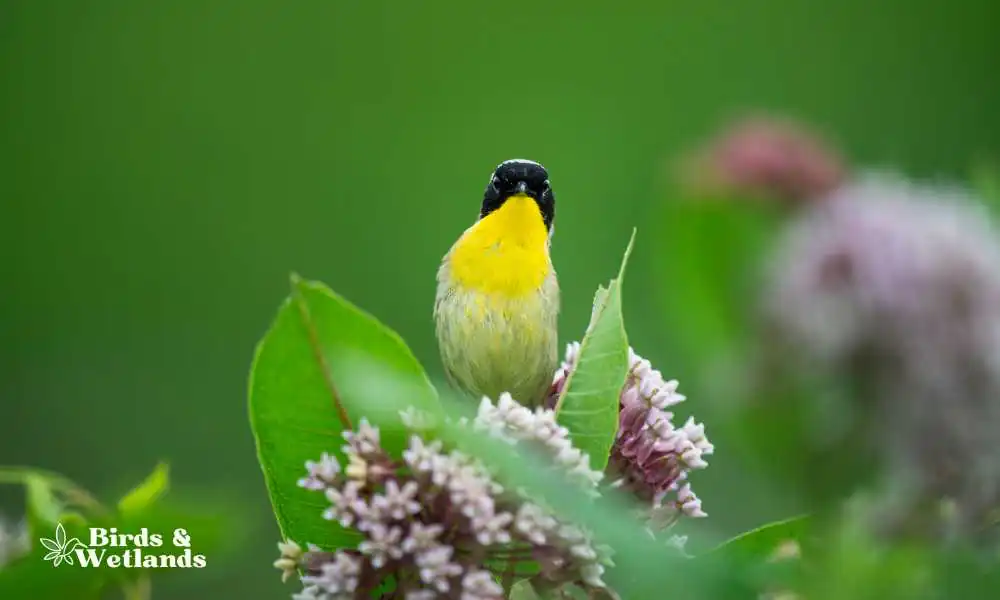
Milkweed is a perennial plant native to North America and grows in many areas of the United States. It is a member of the Asclepias family and is known for its ability to attract birds, butterflies, and other wildlife. The plant has various colors and shapes, ranging from white, red, and purple to yellow and orange.
Milkweed attracts all kinds of insects and butterflies, most notably monarch butterflies which use certain milkweed to host their larvae.
Birds are attracted to milkweed because of the large amount of nectar it produces. This nectar is a great source of energy for the birds and helps them survive during the winter.
Some birds, such as the American goldfinch, use milkweed fibers as nesting materials.
Coral Honeysuckle
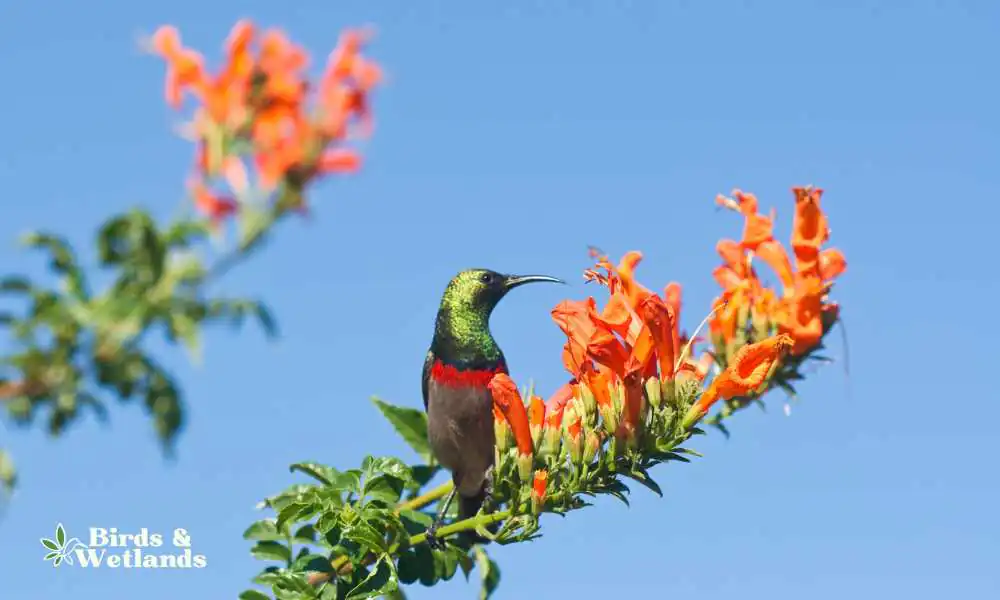
Coral honeysuckle (Lonicera sempervirens), also known as trumpet honeysuckle, is a honeysuckle native to the Eastern United States. It is a fast-growing, deciduous or semi-evergreen vine commonly found in wooded areas and along streams.
Coral honeysuckle is prized for its attractive, trumpet-shaped flowers that bloom from late spring to early autumn. These flowers are typically red or orange, and hummingbirds and other nectar-seeking birds often visit them.
Birds are attracted to coral honeysuckle’s bright and colorful flowers, which serve as a visual cue to attract pollinators. The nectar contained within the flowers provides a source of energy for birds, and its high sugar content attract hummingbirds.
Trumpet honeysuckle also provides a suitable habitat for birds. Its dense foliage can be a hiding place for birds, and its twining stems can be used as perches.
Are plants good for birds?
Yes, plants are good for birds in many ways. They provide food, shelter, and nest sites for various bird species.
One of the most important ways in which plants support birds is by providing a source of food. Many plant species produce fruits, seeds, and nectar, which are important food sources for birds.
For example, berries, insects, and nuts are important food sources for birds during the winter, when other food sources are scarce. Nectar-producing flowers are important food sources for hummingbirds and other seed-eating birds.
Plants grow to provide shelter, partial shade and nesting sites for birds. Trees and shrubs offer protection from predators, inclement weather, and other environmental hazards. Birds often use trees and shrubs to build nests, where they can lay their eggs and raise their young. Winter birds use brushes and trees as temporary shelters and stopover sites during migration.
Why use native plants to attract birds?
Using native plants instead of non-native plants to attract birds in the garden has many advantages. Native plants have evolved in a certain area over time, adapted to the local environment, and are well-known to attract local birds.
One advantage of using native plants is that they are often easier to care for than non-native plants. Native trees and plants are adapted to the local climate and soil conditions, so they usually require less maintenance than non-native plants. This means less time and money spent on care and more time spent enjoying the birds.
Another advantage of using native plants is that they provide a more natural habitat for birds. Easy-to-grow annual native wildflower plants provide food, shelter, and nesting sites for local birds, making them an ideal choice for the avid birdwatcher. Native plants also provide a habitat for native insects, an important part of a bird’s diet.
Using native plants such as dogwood trees can help preserve and support wildlife. Non-native or invasive species of plants can often be invasive and out-compete native species, damaging the local ecosystem. By using native plants instead, you can help to protect local wildlife and maintain a healthy balance in your garden.
What container plants are bird-friendly?
Here are three of the most common potted plants for attracting birds:
Goldenrod
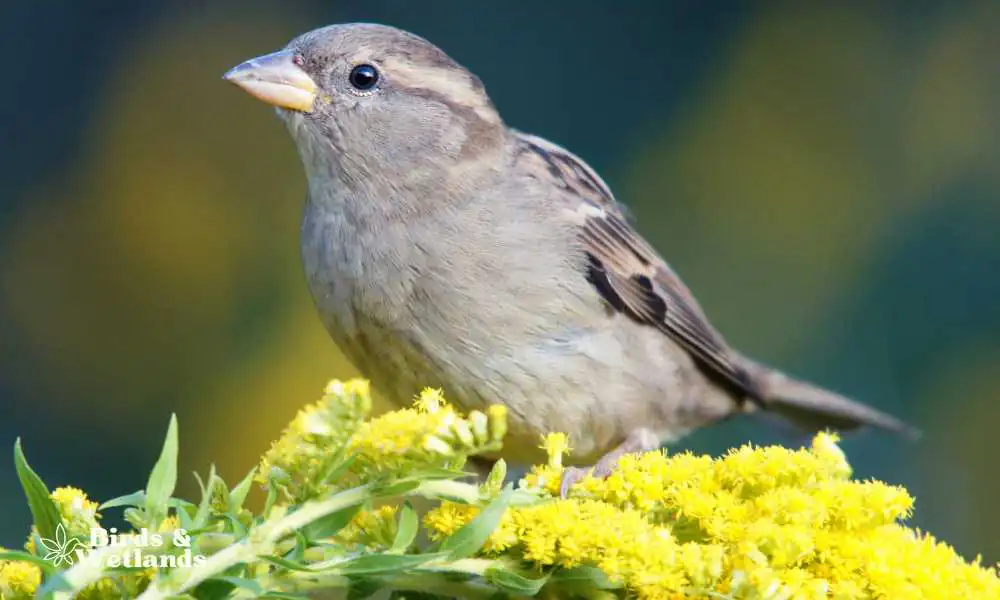
The goldenrod is a bird-friendly potted plant that produces small, bright yellow flower heads in early fall and late summer that provide nectar and small seeds for birds. Its pollen and nectar also attract butterflies and bees. It grows in various soils and prefers full sun, making it an ideal choice for a potted plant.
Marigold
A marigold produces vibrant yellow nectar-rich blooms that attract birds and other wildlife. It can be planted in flowerbeds, window boxes, and containers. To attract birds, plant marigolds in areas with access to sunlight and water and provide a bird feeder (DIY one will do) to provide food for them.
Coral Bells
A coral bell is a perennial flower that grows in various colors. It has a distinct bell-like shape, which makes it attractive to bird visitors, particularly hummingbirds. Planting coral bells in a garden or near bird feeders can provide a great food source and shelter for small birds.
How to attract insectivorous birds to your garden
Insectivorous birds are a type of avian that primarily eat insects. These birds sometimes supplement their diet with other small invertebrates, such as spiders and worms. These quick birds can hover and plunge to capture elusive insects.
These diverse garden birds include flycatchers, swifts, swallows, nightjars, bluebirds, thrushes, warblers, and whooping cranes.
Attracting insectivorous birds to your garden can provide numerous benefits, such as natural pest control and an increase in overall biodiversity. Here are several methods to encourage birds to visit your rain garden:
- Provide a source of water. A birdbath, fountain, or other water sources can majorly attract birds. Ensure that the water source is cleaned regularly to prevent the growth of harmful bacteria and parasites.
- Feed birds. Place bird feeders filled with bird food, seeds or suet in a visible location. Providing food can also be done by planting native flowering plants and shrubs that produce seeds, fruits, and nectar, such as sunflowers, coneflowers, and berry-producing shrubs. Fruit-eating birds are attracted to red-berries, especially in the early spring.
- Create suitable nesting sites by planting a small tree or brush. Insectivorous birds require nest sites for breeding and rearing their young. Installing nest boxes specifically designed for birds such as bluebirds, wrens, and chickadees can encourage them to stay and raise their families in your garden.
- Avoid using pesticides. Pesticides can harm birds and other wildlife, reducing the number of insects available for birds such as northern cardinals and wild turkeys to feed on. Instead, consider using natural pest control methods such as companion planting and encouraging predators such as ladybugs and lacewings.
- Offer a diverse habitat. Providing a diverse habitat in your garden beds can attract various birds. Plant a mixture of trees, shrubs, and wildflowers and create small pockets of dense vegetation. Sow seeds in early fall for spring blooms.
By implementing these methods, you can create a bird-friendly environment that will attract wildlife and insectivorous birds to your garden. Not only will this increase the biodiversity of your garden, but it will also provide natural pest control and a source of enjoyment as you observe the many bird species visiting your yard.
Hugeneroy Heated Bird Bath
The Perfect Winter Helper
The hugeneroy Heated Bird Bath is a much-needed winter survival aid for our feathered friends, offering thermostatically controlled heat, durable construction, and energy-efficient operation.
- Winter-Friendly: Designed specifically for colder seasons, this bird bath maintains water just above freezing point, providing a constant source of liquid water for birds, even in heavy snowfall.
- Energy Efficient: With a built-in 120V 60W high-quality heating element, the birdbath heats up only when necessary, ensuring minimum energy consumption.
- Superior Material: Unlike ceramic or concrete alternatives that may crack under heat, this bird bath is made from quality, BPA-free plastic that withstands heating without generating harmful substances.
- Safety First: Featuring a thermostatically controlled operation, the bird bath automatically cuts off electricity when the water is dry, ensuring safety for the birds and other backyard animals.
- Attractive to Birds: The off-white bird bath blends in with the natural environment, attracting more birds to your backyard. It can also be adorned with colourful stones to make birds feel more secure and enhance your garden aesthetics.

